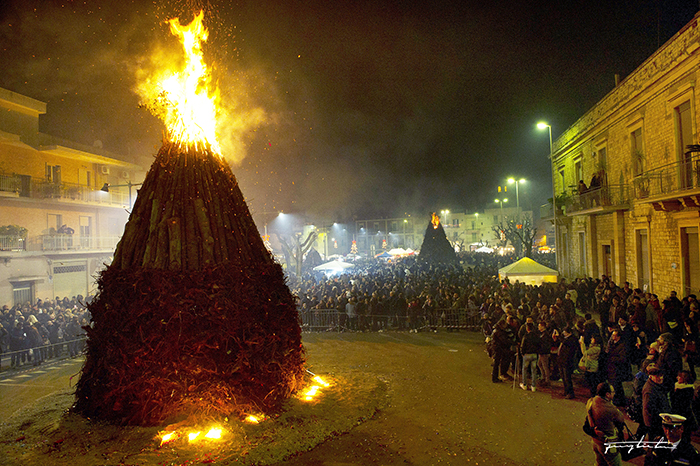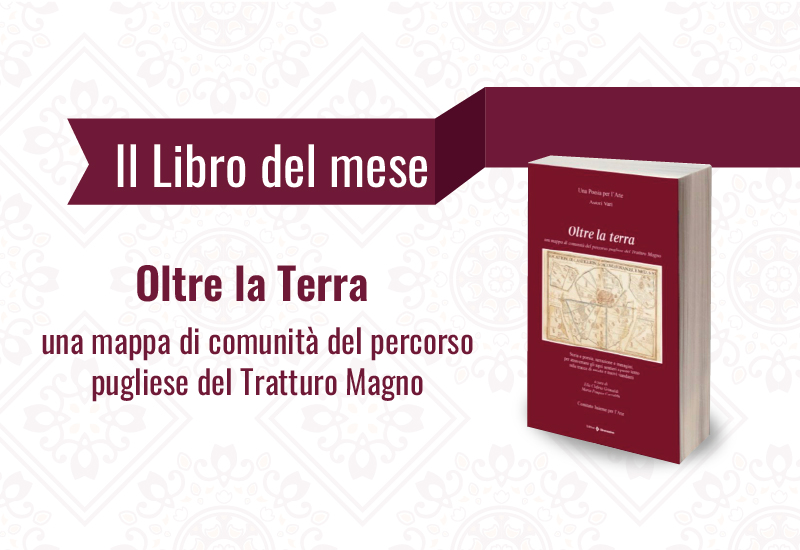INCANDESCENT IMAGES
STAND OUT IN THE SKIES OF APULIA
In the coldest months of the year, fire is the element that dominates patronal festivals. The busy calendar of patron saint's festivals opens the first week of January in CASTELLANA GROTTE (Ba) with 'La Notte delle Fanove', hundreds of grandiose bonfires scattered around the historic centre that, in a Dante-esque landscape, light up the night in honour of Maria SS della Vetrana: according to tradition, it was she who saved the town of Castellana from the Black Death in 1691.
Let yourself be warmed by the live fire as you savour local gastronomic specialities such as taralli, chickpeas and broad beans toasted and the typical hot bruschetta with 'hanging tomatoes' and 'sarôche i scartapìjete', dried fish salted and smoked and dressed with excellent extra virgin olive oil.
Travelling southwards and entering the more characteristic Salento, we come to NOVOLI (Le) with the festival of Sant'Antonio Abate: the protagonist - at the end of the procession of the Saint and after the blessing of the animals - is the 'focara', the largest bonfire in the Mediterranean. A pile, more than twenty metres high, of bundles of vine shoots from which vivid and disruptive flames shoot out like hands stretched towards the sky, while an inexplicable purifying force of fire envelops those who admire it. All around is a jubilation of food and wine with the strong flavours of Salento, with pucce kneaded with olives and onions, 'pezzetti' al sugo and fragrant pittule.
Sloping gently westwards, one enters the Taranto region, the mythical Magna Graecia. Here, at the end of January, precisely in GROTTAGLIE (Ta), a symbolic city in the world for ceramic work to which an entire district is dedicated, on the occasion of the feast of Saint Cyrus, known as the doctor who arrived from Egypt, two enormous pyres (foc're) are made with penitential vine shoots and olive bundles; the largest, in the square dedicated to the saint, is lit on the evening of 30 January, and the fire burns throughout the night; the second, set up in a space near the hospital, is lit the following Sunday, after the return of the statue to its usual home.
SAN MARZANO (Ta) a small agricultural town a few kilometres from Taranto, an ancient Albanian farmhouse is the largest arebesh centre in Italy, guardian of ancient traditions, the land of oil and wine. On 19 March, on the occasion of the Feast of St Joseph, the town's patron saint, there is the rite of the procession of wood to offer to the saint: carts laden with wood and bundles, pulled by horses harnessed with ancient ornaments, parade through the small agricultural centre to reach the Chiesa Matrice.
It is an interminable parade, an impressive travelling forest. Late in the evening, the ancient rite of the bonfire (ziarrij e mate) returns. An enormous pyre is lit to relive the authentic filial bond of one's ancestors with Saint Joseph. On the day of the feast, 'mattre' cooked according to traditional recipes are prepared in the houses and offered to visitors in the square. These are 'le tavolate di San Giuseppe' (St Joseph's tables), banquets with traditional local dishes: mashed broad beans and vegetables, pasta and chickpeas, sauce, bread, meatballs, wine and biscuits, which are offered to citizens and visitors.
If you are looking for strong emotions and have courage to spare, fire may be your test in the town of SAN SEVERO (Fg): join the crowds of 'fujenti' who chase just the fire that runs along rows of pyrotechnic batteries that snake and snake their way through the narrow streets of the old town centre.
Amid clouds of smoke, coloured sparks and the heat that touches the skin, every year in May there are many daredevils who pay homage to the Madonna del Soccorso, the 'Mother of the Black Face', in this way. After the race and fatigue, refreshment is guaranteed with a good glass of the best Sanseveresi wines and sparkling wines accompanied by traditional country dishes such as pancotto, a soup prepared with stale bread and wild herbs.
There are other lights that enchant and light up Puglia with festivity. Called the 'Cathedrals of Light', they are the artistic illuminations whose long tradition is rooted in the land of Salento. You will be enchanted by the thousands of coloured lights, the majestic, baroque-looking sets dancing to the rhythm of music, where passion and tradition have met innovation.
This is the exquisitely Apulian creativity that has been putting on an unparalleled show since May, amidst band concerts and fireworks, as in the small town of DISO (Le) for the festival of the 'santi nosci', St. Philip and St. James, in a concentration of authentic Salento flavours with pittule, ciceri e tria, scapece and 'sagne 'ncannulate'.
Or as is the case in June in the 'Umbelicus del Salento', GALATINA (Le), where you can also visit the Franciscan basilica of Saint Catherine of Alexandria, an authentic masterpiece of Apulian Romanesque art with 15th-century frescoes of the Giotto and Sienese school, and taste typical dishes prepared with the Galatina 'novella' potato, which has earned the Protected Designation of Origin 'DOP' (Protected Designation of Origin) as well as being the home of the famous Salento cake 'il pasticciotto' .
But for more than three hundred years, Galatina has been a destination for tarantulatas from the Terra d'Otranto, who came here on the occasion of the patronal feast to ask for grace from St Peter and St Paul and to drink the well water considered miraculous: three days of feasting to the rhythm of the pizzica and accompanied by the food and wine aromas of the best culinary tradition, while the typical Salento willow wine cheers up the spirits.
Then, in the height of summer, in July, you cannot miss the appointment in SCORRANO (Le) for the 'parazioni', imposing scenes of light that draw the outlines of palaces and ancient buildings, a Baroque-era tradition that is renewed every year thanks to the skill and great artistic work of Scorranesi families who, from generation to generation, hand down the secrets of this art of light on the occasion of the feast of Santa Domenica; a tradition that is now exported all over the world.
Fire, however, remains the leitmotif and the element that closes all patronal festivals in Apulia through the pyrotechnic art of the master stokers: popular creative flair mixes with the science and ancient experience of those who know how to master and combine the pyrotechnic powders to create incandescent images that stand out in the night sky, as happens in ADELFIA (Ba) on the occasion of the Feast of Saint Tryphon, the saint who came from Turkey and is depicted as a peasant and a warrior.
The festival is a real jubilation of band sounds but above all of the lights of the artistic illuminations, which create an enchanting setting for the streets of the centre, and of fireworks that light up the early winter sky. Firework companies give life to a veritable pyrotechnic competition, challenging each other in shows of light and fire that captivate the public.
But the feast of Saint Tryphon brings with it a culinary tradition that attracts gourmets from all over: steaming grills of all kinds of meat gather diners while merriment is celebrated with good local wine - Adelfia is in fact known for its grape cultivation - accompanied by fragrant celery, as in the best peasant gastronomic tradition.
And so, with a nice toast, the calendar of patronal festivities closes in November.
photo by: M. Guglielmi / G. Laera / P. Ladogana / G Armenio / A. D'Amico / M. Cutrone
Scorrano the luminaria capital of the world
Grottaglie, the fireworks display for Fanova
Patroni di Puglia: the feast
Cathedrals of Light
San Marzano, the gastronomy
Adelfia, street food for the feast of St. Tryphon
Fires and Lights
Parabita, the bell tower fire
Adelfia, the pyrotechnic race
Galatina, to the rhythm of pizzica for the feast of St. Peter and Paul
San Marzano di San Giuseppe, the parade of floats for the patronal feast of St. Joseph
Buy products from Pugliautentica, visit our online shop
Scorrano, the illuminations for the patronal feast of Santa Domenica
Adelfia, the patronal feast of St. Tryphon
Galatina, the patronal feast of St. Peter and Paul
Galatina, the fireworks
Scorrano, the luminaria capital of the world
Scorrano, the luminaria capital of the world
Adelfia, the patronal feast of St. Tryphon
Molfetta, the fireworks over the sea
Castellana Grotte, the "Fanove"
Novoli, lighting of the Fanova
San Severo, the fujenti for the feast of Our Lady of Relief
Giovinazzo, bonfire for St. Anthony the Abbot
Gastronomy
San Severo, Chiarappa pyrotechnics
Castellana Grotte, lighting of the fanòve
Novoli, lighting of the Fanova
Grottaglie, the ceramics district
Diso, the patronal feast of St. Philip and James
The Chiarappa family of San Severo (fg), the fourth generation of stokers
Fireworks display by the Chiarappa company of San Severo
Bonfires for the feast of St. Anthony the Abbot
bonfires for the feast of St. Anthony the Abbot with piñatas for cooking legumes



